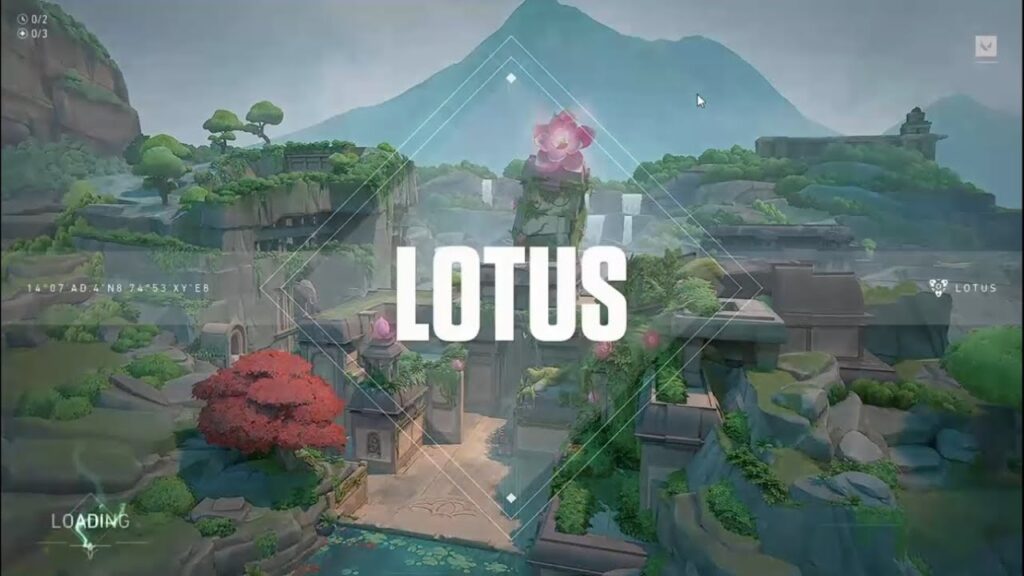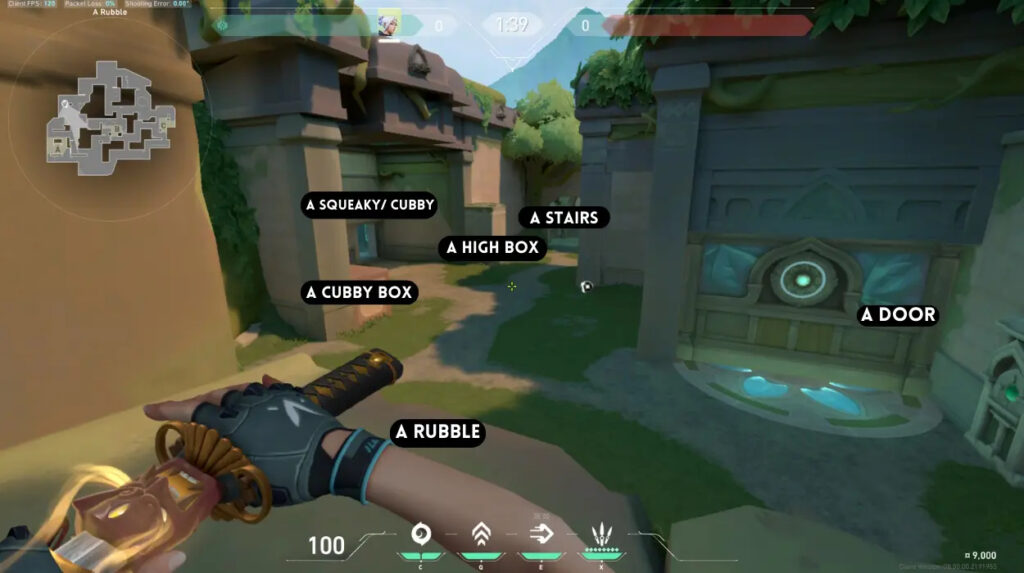
Riot Games consistently delivers impactful new content, particularly in maps and agents. Before the more straightforward Sunset map, Valorant introduced the competitive Lotus map, which emphasized aesthetics while maintaining competitive integrity. Recent adjustments in Episode 8 Act 1 have further improved Lotus’s balance, earning community appreciation. This guide comprehensively covers the Valorant Lotus map, including callouts, recommended agents, and essential tips & tricks.
Valorant Lotus Map Overview
Lotus Release Date and Location
Lotus made its debut on January 10, 2023, in Episode 6, Act 1, presenting an initial design reminiscent of Haven. However, it introduces innovative features that are unprecedented in both Valorant and FPS maps.
Situated in the Western Ghats region of India, the ninth map features rivers, jungles, and, notably, a colossal Lotus tree at its center, its roots and stem extending across the entire terrain.

Additionally, Joe Lansford, Valorant’s level designer, notes, “We drew inspiration from various traditional Indian architectural elements and locations, such as stepwells, rock-cut architecture, and the Dravidian style, including landmarks like the Badami Cave Temples, Ellora Caves, and Rani Ki Vav.” Overall, Lotus authentically captures the visual essence of the western jungle areas of India and has emerged as a pivotal map in deciding competitive matches in Valorant.
Lotus Minimap Layout Overview
Lotus debuted with numerous innovative features, which have remained integral to the map despite various updates. Mirroring the approach of another three-site map, Haven, Lotus distinguishes itself with rotating doors on the A and C sites. These dynamic elements enhance the competitive nature of a three-site map, facilitating rapid rotations and adding strategic depth.
Additionally, the B site features a breakable door, reminiscent of the iconic “squeaky” door in Counter-Strike. Finally, a subtle yet crucial feature is the silent drop on the A site, often overlooked but instrumental in executing successful retakes, particularly in critical moments of gameplay.

Lotus offers ample space for both attackers and defenders to maneuver, contributing to its balanced gameplay and frequent comeback matches in Valorant professional tournaments. The A site is intricately connected to the defenders’ spawn via the silent drop and stairs, while the breakable door facilitates movement between the B and A sites. Additionally, a rotating door in the A lobby provides access to the A tree and site.
The B site is linked to the C site through a connector and another rotating door, with both sites featuring smaller planting areas compared to A, presenting challenges for attackers during execution. The seamless connections between sites enhance the map’s competitiveness, offering a balanced and challenging gameplay experience.
Valorant Lotus Map: Callouts
Now, let’s explore the essential callouts on the Lotus map in Valorant. Please refer to the attached images for a clearer understanding of each callout:
Lotus A Site Callouts
The A site on the Lotus map appears straightforward, featuring easily executed strategies and clear exit routes. Here are the key callouts for the A site in Sunset:
- A Rubble
- A Squeaky/ Cubby
- A Cubby Box
- A High Box
- A Stairs
- A Door

- Silent Drop
- Double Box
- A Default
- A Pillar
- A Tree

Lotus B Site Callouts
The B site on the Lotus map holds significant strategic importance. The callouts for this area in Valorant’s Lotus map are straightforward.
- B Main
- B Main Box
- B Door
- B Default Box
- B Site

- A Link
- B Platform
- B Lower
- B Upper
- C Link

Lotus C site Callouts
The C site on the Lotus map is centered around a massive pillar and offers ample cover for effective defense. Here are all the crucial callouts for the C site:
- C Mound
- Platform
- Waterfall
- CT Box
- CT/Upper

Best Agents for Lotus Map in Valorant
Lotus offers a plethora of duel scenarios where securing control is paramount. Therefore, composing a team with agents capable of exerting control and securing early kills is crucial.
Among support agents, Omen, Viper, and Breach stand out for their ability to aid in controlling the map. Omen’s teleportation abilities are particularly advantageous on the expansive Lotus map. For aggressive dueling and securing early kills, Raze excels, making her an ideal choice for taking control of sites on Lotus.
In a vast map featuring three sites, two aspects consistently prove invaluable: information gathering and defensive capabilities. Lotus particularly benefits from the presence of information-oriented agents like Cypher or Killjoy.
These agents excel at providing crucial information while stationed at different points on the map, complementing the aggression of initiators and duelists. Depending on individual preferences, players may opt to swap Cypher or Killjoy for a Sova or Gekko. Here’s a summary of the agents suitable for the Lotus map:
- Raze
- Omen
- Viper
- Breach
- Cypher
- Killjoy
- Sova/ Gekko
Best Valorant Lotus Map Tactics and Strategies
Lotus epitomizes balance, offering an equitable battleground for both sides. Essential to success on this map is the strategic approach taken by players. Here, we delve into some intriguing strategies, tactics, as well as tips & tricks for mastering the Lotus map.
1. A Rush (Take A Control)
As previously mentioned, the A site boasts a larger planting area compared to the other sites, making it relatively easier to execute a plant. However, this also invites heightened defense from opponents. But fret not, by adhering to our recommended agent list, you can employ the simplest strategy for the Lotus map: the A Rush.

Initiate the assault with your agents equipped with utilities to seize control of A main outside the A lobby. Utilize smokes to obscure the stairs and cubby areas. Proceed to rush through the doors with two agents while the remaining three rush the site.
Once inside the site, maintain positions around the tree and utilize the silent drop for advantageous angles, facilitating a straightforward crossfire setup for the default plant. Give this strategy a try, as it has proven to be highly successful among professional teams such as PRX and Giants.
2. Attack is the Best Defense (B Push)
When faced with tight economy or low buy rounds, consider utilizing a counter-attack strategy focused solely on aggression. With the Attacker spawn positioned closer to the B site, capitalize on this advantage by swiftly rushing down mid, catching opponents off guard in the early rounds.
Avoid venturing alone, as opponents may lurk behind pillars, denying you the opportunity for effective trading. Reserve this Valorant strategy for the Lotus map specifically when finances are limited or when you possess reliable information indicating that no opponents are positioned for a backstab.
3. Use The Rotating Doors More
In Valorant, information is paramount, especially on maps with numerous distractions like Lotus. This map features two types of doors facilitating faster rotations between sites, aiding in swift decision-making and execution.
However, players can manipulate these doors’ sounds to mislead opponents into believing in false rotations, causing significant distractions. It’s crucial not to overuse this tactic to maintain its effectiveness.

Additionally, Omens can utilize teleportation through rotation windows for quick movement. Ensure to avoid placing utilities such as Killjoy’s alarmbot, lockdown, or Cypher’s traps near these doors, as their destruction during rotations can hinder your defensive capabilities. When utilizing the rotating doors, take your time to peek around cautiously, as their movement slows down mid-rotation.
4. Put Backstab Watching Sentinel Utilities
In a map like Lotus, strategically placing your sentinel utilities is crucial for preventing backstabs and maintaining control over the site. Given Lotus’s expansive dimensions, enemies can approach from various angles, making it essential to safeguard against unexpected attacks.
To counter potential backstabs, consider positioning sentinel utilities such as alarmbots or trap wires in areas vulnerable to flanks. By doing so, you can focus your attention on advancing without worrying about being caught off guard.

When attacking the A site, deploy alarmbots or trap wires in the A lobby to provide ample reaction time against potential backstab attempts. For pushes toward the C site, place utilities outside the Attacker spawn to cover potential flanking routes. The B site’s proximity to the Attacker spawn may make it appear easier to attack, but placing utilities in the A or C lobby can still provide valuable defensive coverage against backstab attempts.
5. Do Not Lurk in Valorant’s Lotus
A crucial tip for navigating the Lotus map is to avoid lurking. Given the map’s size and the likelihood of defenders employing defensive utility tactics, lurking becomes inherently challenging and may yield minimal productivity. While players with exceptional aim may occasionally take the risk, it’s generally more effective to stick with teammates.

By staying grouped, you create a sense of numerical superiority, forcing defenders to feel overwhelmed and potentially outnumbered. This strategic approach grants ample time for planting in Lotus before defenders can rotate for backup.
Valorant’s inventive design choices shine through in the tactical balance of the Lotus map. We hope our guide has equipped you with valuable tactical and strategic insights for navigating Valorant’s ninth map. Share in the comments below which tactics you plan to implement in your next game!

0 Comments